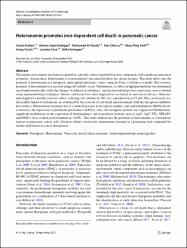| dc.contributor.author | Kaftan, Gizem | |
| dc.contributor.author | Erdoğan, Mümin Alper | |
| dc.contributor.author | Shazly, Mohammed El | |
| dc.contributor.author | Chin Lu, Mei | |
| dc.contributor.author | Ping Shih, Shou | |
| dc.contributor.author | Yu Lin, Hung | |
| dc.contributor.author | Saso, Luciano | |
| dc.contributor.author | Armağan, Güliz | |
| dc.date.accessioned | 2023-10-20T12:44:37Z | |
| dc.date.available | 2023-10-20T12:44:37Z | |
| dc.date.issued | 2023 | en_US |
| dc.identifier.citation | Kaftan, G., Erdoğan, M. A., El-Shazly, M., Lu, M. C., Shih, S. P., Lin, H. Y., ... & Armagan, G. (2023). Heteronemin promotes iron-dependent cell death in pancreatic cancer. Naunyn-Schmiedeberg's Archives of Pharmacology, 1-10. | en_US |
| dc.identifier.issn | 1432-1912 | |
| dc.identifier.uri | https://dx.doi.org/10.1007/s00210-023-02736-7 | |
| dc.identifier.uri | https://hdl.handle.net/20.500.12933/1656 | |
| dc.description.abstract | The marine environment has been recognized as a prolific source of potent bioactive compounds with significant anticancer properties. Among these, heteronemin, a sesterterpenoid-type natural product, has shown promise. This study delves into the potential of heteronemin as a ferroptotic agent against pancreatic cancer, using the Panc-1 cell line as a model. The cytotoxic potential of heteronemin was assessed using cell viability assays. Furthermore, its effect on lipid peroxidation was determined spectrophotometrically, while the changes it induced in autophagy- and ferritin-related protein expressions were evaluated using immunoblotting techniques. Various cell-based tests were employed to scrutinize its anticancer efficacy. Heteronemin displayed a notable cytotoxic effect, reducing cell viability by 50% at a concentration of 55 nM. This cytotoxicity was discernibly linked to ferroptosis, as evidenced by the reversal of cell death upon treatment with the ferroptosis inhibitor, ferrostatin-1. Heteronemin treatment led to a marked increase in ferroptosis markers and malondialdehyde (MDA) levels. Conversely, the expression of glutathione peroxidase-4 (GPX4), a key anti-ferroptotic protein, was suppressed. Furthermore, significant modulations in the expression of ferritinophagy- and iron-related proteins such as Atg5, Atg7, FTL, STEAP3, and DMT-1 were evident post-treatment (p < 0.05). This study underscores the potential of heteronemin as a ferroptosis inducer in pancreatic cancer cells. Given its robust cytotoxicity, heteronemin emerges as a promising lead compound for further exploration in cancer therapeutics. | en_US |
| dc.language.iso | eng | en_US |
| dc.publisher | Springer Verlag | en_US |
| dc.relation.isversionof | 10.1007/s00210-023-02736-7 | en_US |
| dc.rights | info:eu-repo/semantics/embargoedAccess | en_US |
| dc.subject | Ferroptosis | en_US |
| dc.subject | Heteronemin | en_US |
| dc.subject | Pancreatic Ductal Adenocarcinoma | en_US |
| dc.subject | Sesterterpenoid-Type Natural Product | en_US |
| dc.title | Heteronemin promotes iron-dependent cell death in pancreatic cancer | en_US |
| dc.type | article | en_US |
| dc.authorid | 0000-0002-6085-189X | en_US |
| dc.department | AFSÜ | en_US |
| dc.contributor.institutionauthor | Kaftan, Gizem | |
| dc.relation.journal | Naunyn-Schmiedeberg's archives of pharmacology | en_US |
| dc.relation.publicationcategory | Makale - Uluslararası Hakemli Dergi - Kurum Öğretim Elemanı | en_US |
















